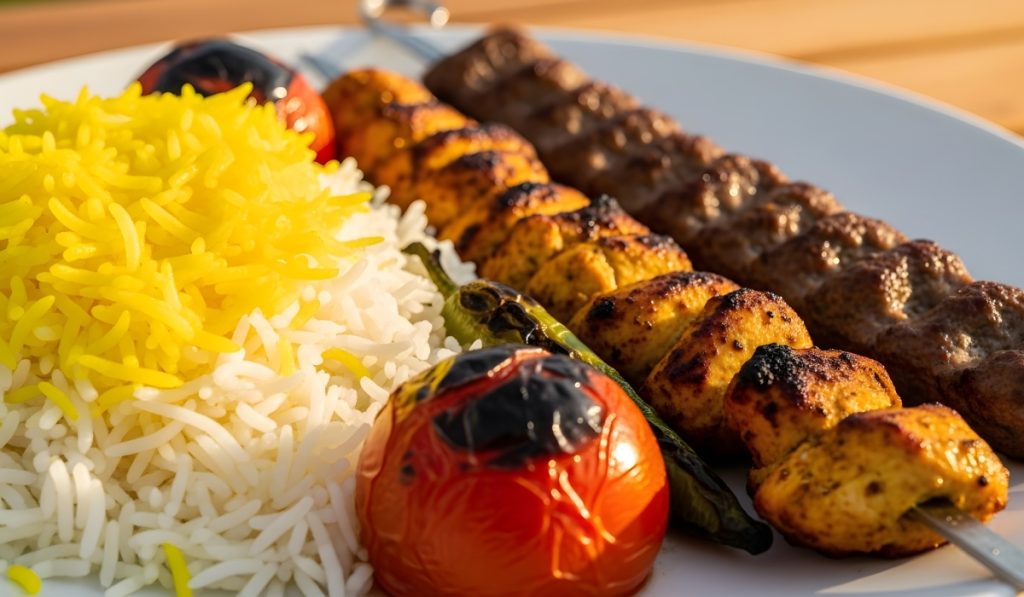When it comes to rich flavors, ancient traditions, and vibrant culinary artistry, few food cultures are as captivating as Persian Cuisine. Praised for its scented rice, expertly grilled meat, subtle stews, and scented spices, it has treated food enthusiasts for centuries and still gives inspiration to chefs globally. Persian food is not merely about consuming something; it’s about savoring a tale that ancient recipes have passed down.
What makes Persian Cuisine truly remarkable is the way it blends history, culture, and flavor. From saffron-infused rice to pomegranate-laced stews, each dish reflects the balance of sweet and savory, simplicity and sophistication. In this guide, we’ll explore the history of Persian cooking, its essential ingredients, regional variations, traditional cooking techniques, popular dishes, cultural significance, and its influence on modern food trends. When you’re done, you’ll see why Persian cuisine is such a prominent contributor to world cuisine and where to find its most authentic taste.
The History of Persian Cuisine
The history of Persian Cuisine stretches back more than 2,500 years, offering a fascinating window into one of the world’s oldest continuous culinary traditions. Persia in the ancient world was geographically situated along the Silk Road, a critical route connecting Europe, Asia, and the Middle East. From this point, the Persians traded spices, grains, and cooking techniques with surrounding cultures, enriching their culinary repertoire with varieties of flavors found nowhere else in the world.
Food was also at the center of royal courts, where kings and nobles hosted refined banquets made up of elaborate dishes, refined rice dishes, and works of art. Food is repeatedly mentioned in ancient Persian literature and poetry, solidifying its role as a sustenance and cultural standard. Contemporary Persian cuisine, such as ghormeh sabzi and fesenjan, carries remnants of this royal heritage, implying that the polish and fineness of the food are not necessarily in the taste but in the history.
Key Ingredients in Persian Cuisine
At the heart of Persian Cuisine are ingredients that balance flavor, fragrance, and visual appeal. Saffron, the most expensive spice in the world, is the most used ingredient in most recipes, lending its golden hue and its delicate perfume to rice and stews. Turmeric, cinnamon, and cardamom add depth and warmth, while rosewater and pomegranate contribute light floral and fruity undertones.
Rice is the most personally unique ingredient, handled with utmost care to produce the optimum texture. Rice is served as chelow, polo, or tahdig with its golden, treasured crust, and it is the epitome of hospitality and tradition. Fresh herbs are used liberally, too, with parsley, cilantro, dill, and mint. Pistachios, almonds, and walnuts bring richness, and apricots and barberries contribute sweet-tartness. Together, these ingredients create the deep, rich flavors that make Persian cuisine unforgettable.
Regional Variations of Persian Cuisine
Because Iran spans deserts, mountains, coastlines, and fertile valleys, Persian Cuisine varies widely across the country’s regions. In affluent provinces in the north by the Caspian Sea, there is a lot of fresh herbs, garlic, and fish, sometimes with rice flavored with local spices. In southern Iran, accessible through the Persian Gulf, the cuisine becomes spicier and seafood-based, featuring dishes that incorporate chili peppers, tamarind, and aromatic spices.
In the west mountains, heavy stews full of lamb, beans, and yogurt are the standard, and in the eastern provinces, Central Asian cuisine dominates, with saffron- and fruit-drenched pilafs of rice and pilafs. Regional variation prevents the Persian cuisine from ever getting boring; each region contributes its own flavor, method of preparation, and seasonally found ingredients to the grand tapestry of the cuisine.
Cooking Techniques in Persian Cuisine
One of the reasons Persian Cuisine feels so refined is its meticulous cooking techniques. Stewing, or khoresh, is a ubiquitous technique that produces fully flavored foods, cooked for anywhere from a few hours to several hours to develop layers of faultlessly balanced flavors. Traditional stews, such as ghormeh sabzi (a herb, bean, and lamb stew) or fesenjan (a pomegranate and walnut stew), illustrate how thoughtful layering can produce unforgettable cuisine.
Preparation of rice is an art form in itself. Parboiling and steaming the rice cause every grain to be fluffy and separate, with the valuable tahdig —the crunchy, golden-brown crust that forms at the bottom —providing texture and delight to any meal. Grilling, or kebab, is no less popular, with newly-marinated meats like koobideh or joojeh being grilled on charcoals for smoky, tender outcomes. These processes exemplify the Persian fixation on precision, attention, and respect for the natural integrity of every ingredient.
Popular Dishes in Persian Cuisine
Some of the world’s most memorable dishes come from Persian Cuisine, and each one tells a story of heritage and flavor. Kebabs, from the flavorful ground lamb koobideh to the saffron-marinated chicken joojeh, are staples that demonstrate grilling greatness. Ghormeh sabzi, Iran’s de facto national dish, is an herb stew with beans, lamb, and dried lime that creates a rich, earthy taste. Fesenjan is another classic staple, combining walnuts and pomegranate molasses into a thick, acidic stew served as a main course on special nights.
Other popular hits include zereshk polo (barberry rice served alongside chicken), dolmeh (rice and herb-stuffed vegetables), and ash reshteh (a thick, hearty bean and herb noodle soup). Desserts, such as Persian sweets, like baklava, saffron ice cream, and sholeh zard (saffron rice pudding), end meals on a high note. They are all perfect examples of the convention and artistry that render Persian food popular around the world.

Cultural Significance of Persian Cuisine
Food is deeply woven into the fabric of Iranian life, and Persian Cuisine holds immense cultural significance. Dinner is not merely something to eat; dinner is a sign of hospitality, family, and festivity. In Iranian culture, putting food on the table is a gesture of respect and generosity, and most traditional cuisine is tightly tied to celebrations and holidays.
Nowruz, the Persian New Year, itself takes the form of extravagant spreads called haft-sin, complete with symbolic dishes such as apples, garlic, and herbs. Weddings and big family celebrations typically feature decadent rice platters and kebabs, and even routine meals affirm abundance and equilibrium. The emphasis on food is indicative of the Iranian conviction that food is a social delight rather than merely a requirement.
Modern Influence of Persian Cuisine
Today, Persian Cuisine is finding its place on the global stage. Iranian restaurants in city centers worldwide are introducing authentic Persian flavors to new customers, and creative chefs are experimenting with fusion dishes that blend traditional Persian spices and ingredients with modern cooking techniques. This change is revealing Persian cuisine to traditionalists and adventurous consumers alike.
The cuisine also appeases the latest health-conscious trends. Its incorporation of fresh herbs, beans, lean protein, and cardiovascular-friendly fats makes Persian cuisine easily integrate into healthy, balanced diets. Blogs and social media further claimed it as one of their own, spreading Persian ingredients and dishes further and broader than ever before. As global appreciation for Persian cuisine continues to grow, its timeless appeal remains evident.
Conclusion: Where to Experience the Best Persian Cuisine
In this guide, we’ve explored the history, ingredients, regional variations, cooking techniques, popular dishes, cultural traditions, and modern influence of Persian Cuisine. With its ideal balance of taste, fragrance, and loveliness, it is not surprising that Persian cuisine is still the world’s most valued cuisine.
For those who want to savor authentic flavors locally, the best choice is Parkway Kebab. Renowned for its juicy kebabs, saffron rice, and traditional stews, Parkway Kebab brings the authentic taste of Persian cooking to your table. Whether you’re new to Persian food or a longtime fan, Parkway Kebab is the perfect destination to experience the richness, hospitality, and artistry of Persian Cuisine.
